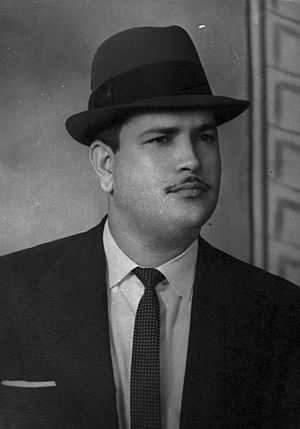Francisco Caamaño facts for kids
Quick facts for kids
Francisco Caamaño
|
|
|---|---|
 |
|
| Member of Revolutionary Committee of April 1965 in the Dominican Republic | |
| In office May 4, 1965 – August 30, 1965 |
|
| Preceded by | Triumvirate |
| Succeeded by | Héctor García-Godoy {interim) |
| Personal details | |
| Born | June 11, 1932 San Juan de la Maguana |
| Died | February 16, 1973 (aged 40) San José de Ocoa |
| Nationality | Dominican |
| Spouse |
María Paula Acevedo Guzmán
(m. 1958) |
| Relations | Danilo Medina (second-cousin) Lucía Medina (second-cousin) Claudio Caamaño Grullón (first cousin-once removed) Claudio Caamaño Vélez (first cousin-twice removed) |
| Children | Alberto Alexander Francis Alexander Paola Alexandra |
| Occupation | Soldier, politician |
Francisco Alberto Caamaño Deñó (born June 11, 1932 – died February 16, 1973) was a Dominican soldier and politician. He became the leader of the Dominican Republic during the Civil War of 1965. This war started on April 24, 1965. Caamaño was a key leader in the effort to bring back the elected President, Dr. Juan Bosch, who had been removed from power in 1963.
Contents
Early Life and Military Career
Francisco Alberto Caamaño Deñó was born in San Juan de la Maguana on June 11, 1932. His father, General Fausto Caamaño Medina, was a well-known military officer. His father held important positions in the government before Francisco became famous.
Francisco Caamaño came from a family with many military members. He joined the Dominican Navy when he was young. He quickly moved up in rank. Before the end of the Trujillo era, Caamaño led a special police unit.
In 1958, Caamaño married María Paula Acevedo Guzmán, who was known as Chiquita. They had three children together: Alberto Alexander, Francis Alexander, and Paola Alexandra.
The 1965 Civil War
The Dominican Republic Civil War began on April 24, 1965. Francisco Caamaño was one of the main leaders. He wanted to bring back President Juan Bosch, who had been overthrown in 1963. The people who supported Bosch were called the Constitucionalistas. They wanted to return to a fair and legal government. They were against the military leaders who were in charge.
The Constitucionalistas took control of Santo Domingo in the first few days of the uprising. Because of this, the U.S. President Lyndon B. Johnson sent the U.S. military to the Dominican Republic. This was called Operation Power Pack. The U.S. said they needed to protect American citizens. They also worried that the Constitucionalistas might lead to a communist government. They did not want "another Cuba" in the region.
Becoming President
During the civil war, Caamaño became the leader of the Dominican Republic. He was seen as the true president by many. His Constitucionalistas forces fought for several months. They were outnumbered and had fewer weapons than the combined forces against them.
Eventually, Caamaño and his men agreed to a peace deal. This ended the Constitucionalista government. Caamaño faced many threats and attacks after this. He accepted an agreement helped by the United States government.
On August 30, 1965, President Caamaño and his rival, Antonio Imbert Barrera, both stepped down. A temporary president, Héctor García-Godoy, took over.
Later Years and Legacy
The temporary president, Héctor García-Godoy, sent Colonel Caamaño to be a military helper at the Dominican Embassy in the United Kingdom. While he was there, he met with officials from Cuba. He then went to Cuba to start a group of fighters. He planned to return to the Dominican Republic with these fighters.
In late 1973, Caamaño led a small group of rebels. They landed at Playa Caracoles and went into the mountains. Their goal was to start a revolution to remove President Joaquín Balaguer. Balaguer's government was very strict at that time.
After a few weeks of fighting, Caamaño's group was surrounded by the Dominican Army. They were defeated in a battle. Caamaño was hurt and captured by government forces. He was then killed.
About 20 years later, the Dominican government officially honored Caamaño as a hero. He was recognized for trying to bring back a fair government to his country. Today, a street in Santo Domingo is named Presidente Caamaño. There is also a metro station in Santo Domingo named after him.
See also
 In Spanish: Francisco Caamaño para niños
In Spanish: Francisco Caamaño para niños
- History of the Dominican Republic
- Dominican Civil War
Images for kids


